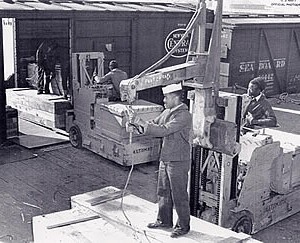
This week, relatives, historians and the general public are remembering one of the deadliest industrial disasters in United States history: a massive explosion in the Bay Area that took hundreds of lives during World War II.
Port Chicago was a Navy facility near Concord where sailors loaded munitions onto ships headed for the Pacific. On the night of July 17, 1944, the men were loading up the SS Quinault Victory and the SS E.A. Bryan when the mishandling of weapons led to a deadly explosion that killed 320 people. Of the men who died, 202 were African-Americans working in a segregated Navy. A Navy website describes what happened:
At 10:18 p.m., a hollow ring and the sound of splintering wood erupted from the pier, followed by an explosion that ripped apart the night sky. Witnesses said that a brilliant white flash shot into the air, accompanied by a loud, sharp report. A column of smoke billowed from the pier, and fire glowed orange and yellow. Flashing like fireworks, smaller explosions went off in the cloud as it rose. Within six seconds, a deeper explosion erupted as the contents of the E.A. Bryan detonated in one massive explosion. The seismic shock wave was felt as far away as Boulder City, Nevada. The E.A. Bryan and the structures around the pier were completely disintegrated. A pillar of fire and smoke stretched over two miles into the sky above Port Chicago. The largest remaining pieces of the 7,200-ton ship were the size of a suitcase. A plane flying at 9,000 feet reported seeing chunks of white hot metal "as big as a house" flying past. The shattered Quinault Victory was spun into the air. Witnesses reported seeing a 200-foot column on which rode the bow of the ship, its mast still attached. Its remains crashed back into the bay 500 feet away.
Pittsburg resident Frank DeRosa was 17 at the time. He was living several miles away and was carrying his baby sister to bed when he felt the blast.
"All of a sudden it was like a wind, like a tornado," he said. The large window behind him shattered, hurling shards of glass at his back, and cutting through his thick flannel pajamas.
"I got cut a few times, and mostly I was bruised," he said. "The little kid was in my chest and I was hunched over, so [she] never got one little scratch."
